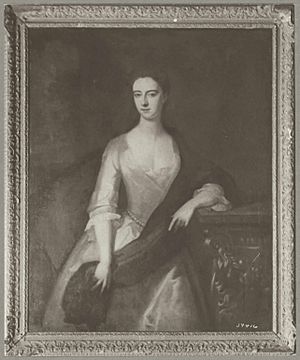Thomas Bladen facts for kids
Quick facts for kids
Thomas Bladen
|
|
|---|---|
| 8th Governor of Restored Proprietary Government | |
| In office 1742–1746/47 |
|
| Preceded by | Samuel Ogle |
| Succeeded by | Samuel Ogle |
| Member of Parliament for Ashburton | |
| In office 1735–1741 Serving with Roger Tuckfield, Joseph Taylor
|
|
| Preceded by | Sir William Yonge Roger Tuckfield |
| Succeeded by | John Harris John Arscott |
| Member of Parliament for Steyning | |
| In office 1727–1734 Serving with The Viscount Vane
|
|
| Preceded by | John Gumley William Stanhope |
| Succeeded by | Marquess of Carnarvon Sir Robert Fagg, Bt |
| Personal details | |
| Born | 23 February 1698 Annapolis, Maryland |
| Died | 2 February 1780 (aged 81) Leyton Grange, England |
| Spouses |
Barbara Janssen
(m. 1731–1780) |
| Relations | Martin Bladen (uncle) Nathaniel Bladen (grandfather) William Capell (grandson) Thomas Bladen Capel (grandson) |
| Children | Barbara St John Harriet, Countess of Essex |
| Parents | William Bladen Anne Van Swearingen |
| Education | Westminster School |
Thomas Bladen (born 1698, died 1780) was an important leader in early America. He was a politician who served in the British Parliament. He also became the Governor of Maryland, a colony in North America, from 1742 to 1747.
Contents
Early Life of Thomas Bladen
Thomas Bladen was born in Maryland in 1698. His father, William Bladen, moved to Maryland in 1690. Thomas was the oldest son. His sister, Anne Bladen, married Benjamin Tasker Sr., who also became a Governor of Maryland.
Thomas Bladen's uncle was Colonel Martin Bladen. Colonel Bladen was a Commissioner for Trade and Plantations.
Thomas traveled to England in 1712. He went to school at Westminster School. When his father died in 1718, Thomas sold his property in Maryland.
Thomas Bladen's Political Career
Thomas Bladen became a Member of Parliament (MP) for Steyning in 1727. He was chosen for this role by the Duke of Chandos. Bladen usually voted with the government.
In 1735, he became an MP for Ashburton. He served in this role until 1741. He also served in the military as a colonel.
Life as Governor of Maryland
In 1742, Bladen returned to Maryland. He became the provincial Governor. He was the first governor born in Maryland. He also served as a surveyor and a chancellor.
As governor, he helped make peace with the Six Nations. He also worked with Pennsylvania leaders to settle the border between Maryland and Pennsylvania.
Governor's Residence Project
When Bladen arrived in Maryland, the Legislature gave him money to build a new home. In 1744, he bought land in Annapolis. He started building a house, which is now McDowell Hall at St. John's College.
However, Bladen disagreed with the Legislature about the building's design. He also had a lawsuit with the previous owner of the land. Because of these problems, construction on the house stopped.
First Ice Cream Social
While he was governor in Maryland, Bladen hosted the first ice cream social in the United States. This event happened at a dinner party in 1744.
End of Governorship
Bladen quickly became an unpopular governor. He was removed from office in 1746. People thought he was "tactless and quarrelsome."
He returned to England in 1746. Samuel Ogle became governor after him. Samuel Ogle was married to Bladen's niece, Anne Tasker. Ogle had been governor before Bladen.
Thomas Bladen's Family Life
In 1731, Thomas Bladen married Barbara Janssen in England. Her father was Sir Theodore Janssen, 1st Baronet. Barbara's sister, Mary Janssen, was married to Charles Calvert, 5th Baron Baltimore.
Soon after his marriage, Bladen bought the Glastonbury Abbey estate. He reportedly won it from the Duke of Devonshire in a game of dice.
Thomas and Barbara Bladen had two daughters:
- Barbara Bladen (1733–1821), who married Henry St John.
- Harriet Bladen (1735–1821), who married William Capell, 4th Earl of Essex. She became the Countess of Essex.
Bladen lived at Leyton Grange in England. He died there in 1780. His wife, Barbara, died in 1783. Their daughters later sold the Glastonbury estate in 1799.
Legacy of Thomas Bladen
The governor's residence that Bladen started building remained unfinished. In 1766, its roof collapsed. Today, this building is the main hall of St. John's College. It is called McDowell Hall. People sometimes call it "Bladen's Folly" because of the problems during its construction.
The town of Bladensburg, Maryland, was named after him. It was first called Garrison's Landing. It was renamed in the first year of Bladen's time as governor.


